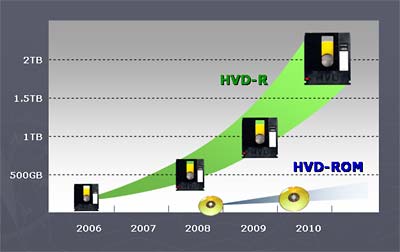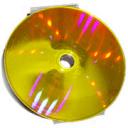 A review of the state-of-the-art in optical storage technology from Sony scientists caught my eye while I was data mining journal ToC feeds recently. The demise of the Toshiba HD DVD format and the emergence of Sony’s Blu-Ray as the winner has been this decade’s equivalent of the VHS-Betamax face-off of the 1980s.
A review of the state-of-the-art in optical storage technology from Sony scientists caught my eye while I was data mining journal ToC feeds recently. The demise of the Toshiba HD DVD format and the emergence of Sony’s Blu-Ray as the winner has been this decade’s equivalent of the VHS-Betamax face-off of the 1980s.
While many commentators point out that other technologies, such as solid state storage are waiting in the wings white-out optical, the Sony team sees growth lying ahead and the development of a CD-sized holographic disk that can store several terabytes of data available to the consumer realm.
Writing in a forthcoming issue of the International Journal of Product Development (2008, 5, 447-454), Toshiharu Okanishi, Toru Takeda, and Mamoru Nishio of the Technology Strategy and Development Department, at Sony Corporation, in Tokyo, Japan, point out that the “pit-by-pit” optical recording and reading technology used initially in the CD, then the DVD and more recently with sharper blue-purple lasers will see continued growth in one form or another. However, there will be no significant jumps in the near future, they say. There will be some significant improvement with the emergence of so-called near-field recording and super-resolution near-field recording, which will push the boundaries of what is possible with pit-by-pit to data densities.
Data storage technology, whether IBM’s magnetic disks of the 1970s, which are still with us, or the 1980s optical technology pioneered by Philips, is an enormous market. Magnetic hard drives – the Winchester technology – have progressed from disks of a few megabytes to the multi-platter terabyte beasts of today, total annual market is estimated at US$25 billion. In contrast, optical represents a market of $10b, but with rewritable disks adding some $3b each year to that total.
The Sony team offers a cosy view of the Winchester and Optical partnership:
Both technologies and both businesses have been developed back-to-back for the last 25 years and they will go hand-in-hand into the future, too.
While R&D in magnetic disks has continued apace, the technology remains locked pretty much in the 1970s. That said, storage and reliability of grown enormously and disks got much smaller since the early days. Nevertheless, new ways to make optical disks, to code and decode them and to ensure error correction have pushed the partner technology forward rapidly too. The development of high-frequency semiconductor lasers was key to the progression from CD (several hundred megabytes) to Blu-Ray disks that can store 25 gigabytes on a single layer. And almost as an aside there is Ultra Density Optical (UDO) storage from Plasmon, which uses highly precise tracking to increase the data density and allows 120 and 240 Gb capacities.
The Sony team points out that the technology that makes optical storage possible – the semiconductor lasers that read-write the disks, encoding and decoding systems, and the error correction systems have pretty much converged. With such a state of affairs there is little room for a significant jump in bit-by-bit optical storage in the near future. They also assert that there is room in the market for a mere ten percent increase in volume sales. Both factors coupled with falling revenues will reduce R&D spending still further. A paradigm shift could be the only change that could drive the industry forward – holographic disks could represent just such a shift.
It’s a paradigm shift whose time is long overdue, however. The concept of holographic recording was proposed way back in the 1970s and such systems have been used for decades for high-level purposes on incredibly expensive systems for companies and organisations that need to store vast amounts of data.
It took a significant development in chemistry, the invention of photo-polymer recording materials, before researchers could foresee a practical way to implement holographic recording. Okanishi and colleagues emphasise that holographic recording is a totally different approach compared to other optical storage systems, but requires a shift in the costly precision technology currently available to bring it to the mainstream consumer.
 First off, there are two types of hologram possible – thin film and volume. With a volume hologram device used for large data storage purposes it is possible to store different pieces of data on the same area of the data medium, that is at different depths instead of a single layer (as in a CD) within a cone-shaped volume. Indeed, prototype systems promise storage of 60000 bits per pulse in a single 3D pit on a disk the same size as a CD. “This means the total capacity of a package is basically proportional to the three-dimensional volume of the medium,” the researchers explain. The team points out that to make such a system work well requires coherent optimisation of different parts of the technology in parallel.
First off, there are two types of hologram possible – thin film and volume. With a volume hologram device used for large data storage purposes it is possible to store different pieces of data on the same area of the data medium, that is at different depths instead of a single layer (as in a CD) within a cone-shaped volume. Indeed, prototype systems promise storage of 60000 bits per pulse in a single 3D pit on a disk the same size as a CD. “This means the total capacity of a package is basically proportional to the three-dimensional volume of the medium,” the researchers explain. The team points out that to make such a system work well requires coherent optimisation of different parts of the technology in parallel.
The Holographic Versatile Disc (HVD) format utilises two lasers – a red and a green which are piped into a single pulse of light. The green laser picks up data from interference patterns in a holographic layer, while the red acts as a control or reference beam. The potential is for a system with a capacity of almost 3.9 terabytes (39000 gigabytes), which is nearly 6000 times as much data as can be stored on a CD, hundreds of times a DVD. Costs will initially make HVD inaccessible to most consumers with drives costing tens of thousands of dollars and the disks themselves at least a couple of hundred dollars. As with most technology, prices will fall as the market matures. “I am not sure which (consumer or professional) market HVD is currently aiming,” Okanishi told Sciencebase, “But it is a good challenge to gather industrial eyes to this prospective technology.”
 The other benefits of HVD over DVD will be data transfer rates, with speeds some six times faster. Such speeds will be quite useful if one is carrying out file transfers with the entire US Library of Congress (storable on just 6 HVDs), the whole of Google Earth data (2 disks) or 12000 hours of mpeg files (that’s a year’s continual viewing).
The other benefits of HVD over DVD will be data transfer rates, with speeds some six times faster. Such speeds will be quite useful if one is carrying out file transfers with the entire US Library of Congress (storable on just 6 HVDs), the whole of Google Earth data (2 disks) or 12000 hours of mpeg files (that’s a year’s continual viewing).
There are various companies working on HVD, including Optware (site offline), InPhase Technologies (also offline) and its patented Tapestry Media, Hitachi Maxell Ltd. Other companies and more information can be found on the HVD Forum